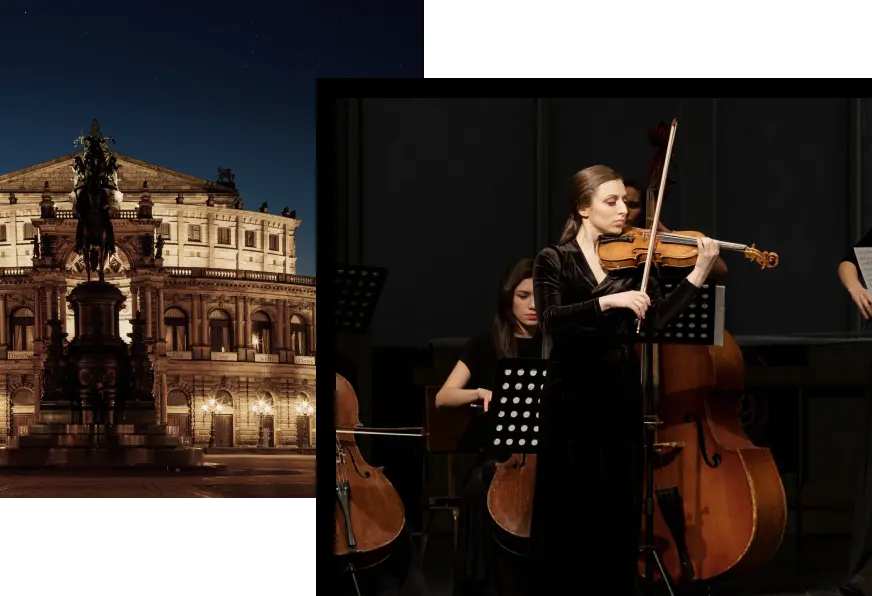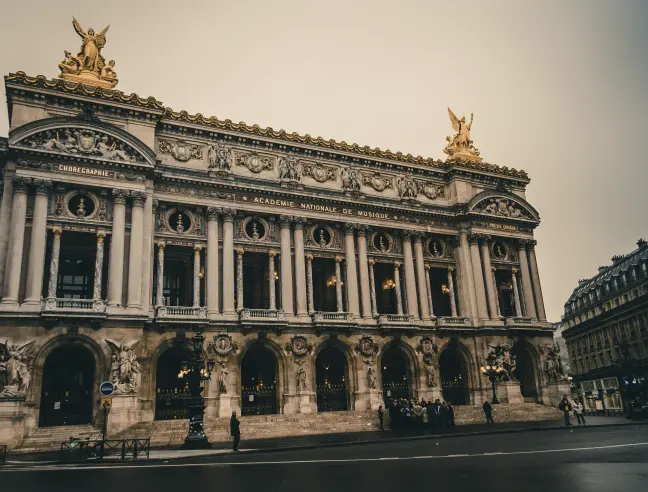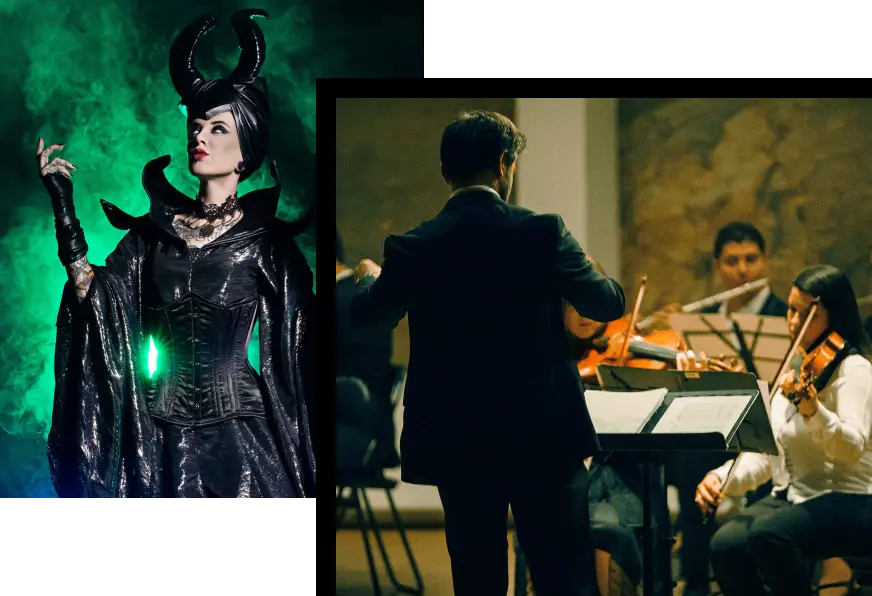
Our Vision
Feugiat risus, elit tortor vel nulla pulvinar. Elementum sit diam congue in egestas iaculis integer. Lorem blandit dui ut nunc, vulputate feugiat mauris. Lorem tellus ac sit tristique. Vitae mauris mattis sit sed pretium id sit vel tellus.
Feugiat risus, elit tortor vel nulla pulvinar. Elementum sit diam congue in egestas iaculis integer. Lorem blandit dui ut nunc.
Know Our History

Academie Nationale De Musique
The second serious fire in the Odessa Opera House occurred on March 15, 1925, after J. Meyerber’s opera The Prophet, as a result of careless handling of fire. The flames damaged the hall, destroyed the stage, scenery and costumes. The music library and the curtain on which the artist F. Lefler painted a scene from “Ruslan and Lyudmila” were damaged. But a year later, the theater resumed performances, the stage received new technical equipment, two reinforced concrete curtains were equipped, which, if necessary, cut off the stage from the auditorium and office space. The new decorative curtain was made according to the sketches of the famous theatrical artist O. Golovin. After the October Revolution, the opera house became state-owned, and in 1926 received the status of “academic”.
In those years, Alexander Pirogov, Platon Tsarevich, Yuri Kiporenko-Damansky, Ivan Alchevsky, “Ukrainian Chaliapin” Ivan Patorzhinsky, Maria Litvinenko-Wolgemut and many others shone on the stage. The repertoire included “Ruslan and Lyudmila” by M. Glinka, “Mermaid” by O. Dargomyzhsky, “Prince Igor” by O. Borodin, “The Queen of Spades” and “Mazepa” by P. Tchaikovsky, “Aida” by J. Verdi, “Faust” by Sh. Gounod and “Carmen” by J. Bizet. Along with Russian and Western European operas, the works of Ukrainian authors – “Taras Bulba” and “Natalka Poltavka” by M. Lysenko, “Zaporozhets over the Danube” by S. Hulak-Artemovsky were heard from the stage. Operas appeared on Ukrainian plots – “Sorochyn Fair” by M. Mussorgsky, “Shoes” by P.

Academie Nationale De Musique
The second serious fire in the Odessa Opera House occurred on March 15, 1925, after J. Meyerber’s opera The Prophet, as a result of careless handling of fire. The flames damaged the hall, destroyed the stage, scenery and costumes. The music library and the curtain on which the artist F. Lefler painted a scene from “Ruslan and Lyudmila” were damaged. But a year later, the theater resumed performances, the stage received new technical equipment, two reinforced concrete curtains were equipped, which, if necessary, cut off the stage from the auditorium and office space. The new decorative curtain was made according to the sketches of the famous theatrical artist O. Golovin. After the October Revolution, the opera house became state-owned, and in 1926 received the status of “academic”.
In those years, Alexander Pirogov, Platon Tsarevich, Yuri Kiporenko-Damansky, Ivan Alchevsky, “Ukrainian Chaliapin” Ivan Patorzhinsky, Maria Litvinenko-Wolgemut and many others shone on the stage. The repertoire included “Ruslan and Lyudmila” by M. Glinka, “Mermaid” by O. Dargomyzhsky, “Prince Igor” by O. Borodin, “The Queen of Spades” and “Mazepa” by P. Tchaikovsky, “Aida” by J. Verdi, “Faust” by Sh. Gounod and “Carmen” by J. Bizet. Along with Russian and Western European operas, the works of Ukrainian authors – “Taras Bulba” and “Natalka Poltavka” by M. Lysenko, “Zaporozhets over the Danube” by S. Hulak-Artemovsky were heard from the stage. Operas appeared on Ukrainian plots – “Sorochyn Fair” by M. Mussorgsky, “Shoes” by P.

Academie Nationale De Musique
The second serious fire in the Odessa Opera House occurred on March 15, 1925, after J. Meyerber’s opera The Prophet, as a result of careless handling of fire. The flames damaged the hall, destroyed the stage, scenery and costumes. The music library and the curtain on which the artist F. Lefler painted a scene from “Ruslan and Lyudmila” were damaged. But a year later, the theater resumed performances, the stage received new technical equipment, two reinforced concrete curtains were equipped, which, if necessary, cut off the stage from the auditorium and office space. The new decorative curtain was made according to the sketches of the famous theatrical artist O. Golovin. After the October Revolution, the opera house became state-owned, and in 1926 received the status of “academic”.
In those years, Alexander Pirogov, Platon Tsarevich, Yuri Kiporenko-Damansky, Ivan Alchevsky, “Ukrainian Chaliapin” Ivan Patorzhinsky, Maria Litvinenko-Wolgemut and many others shone on the stage. The repertoire included “Ruslan and Lyudmila” by M. Glinka, “Mermaid” by O. Dargomyzhsky, “Prince Igor” by O. Borodin, “The Queen of Spades” and “Mazepa” by P. Tchaikovsky, “Aida” by J. Verdi, “Faust” by Sh. Gounod and “Carmen” by J. Bizet. Along with Russian and Western European operas, the works of Ukrainian authors – “Taras Bulba” and “Natalka Poltavka” by M. Lysenko, “Zaporozhets over the Danube” by S. Hulak-Artemovsky were heard from the stage. Operas appeared on Ukrainian plots – “Sorochyn Fair” by M. Mussorgsky, “Shoes” by P.

Academie Nationale De Musique
The second serious fire in the Odessa Opera House occurred on March 15, 1925, after J. Meyerber’s opera The Prophet, as a result of careless handling of fire. The flames damaged the hall, destroyed the stage, scenery and costumes. The music library and the curtain on which the artist F. Lefler painted a scene from “Ruslan and Lyudmila” were damaged. But a year later, the theater resumed performances, the stage received new technical equipment, two reinforced concrete curtains were equipped, which, if necessary, cut off the stage from the auditorium and office space. The new decorative curtain was made according to the sketches of the famous theatrical artist O. Golovin. After the October Revolution, the opera house became state-owned, and in 1926 received the status of “academic”.
In those years, Alexander Pirogov, Platon Tsarevich, Yuri Kiporenko-Damansky, Ivan Alchevsky, “Ukrainian Chaliapin” Ivan Patorzhinsky, Maria Litvinenko-Wolgemut and many others shone on the stage. The repertoire included “Ruslan and Lyudmila” by M. Glinka, “Mermaid” by O. Dargomyzhsky, “Prince Igor” by O. Borodin, “The Queen of Spades” and “Mazepa” by P. Tchaikovsky, “Aida” by J. Verdi, “Faust” by Sh. Gounod and “Carmen” by J. Bizet. Along with Russian and Western European operas, the works of Ukrainian authors – “Taras Bulba” and “Natalka Poltavka” by M. Lysenko, “Zaporozhets over the Danube” by S. Hulak-Artemovsky were heard from the stage. Operas appeared on Ukrainian plots – “Sorochyn Fair” by M. Mussorgsky, “Shoes” by P.

Academie Nationale De Musique
The second serious fire in the Odessa Opera House occurred on March 15, 1925, after J. Meyerber’s opera The Prophet, as a result of careless handling of fire. The flames damaged the hall, destroyed the stage, scenery and costumes. The music library and the curtain on which the artist F. Lefler painted a scene from “Ruslan and Lyudmila” were damaged. But a year later, the theater resumed performances, the stage received new technical equipment, two reinforced concrete curtains were equipped, which, if necessary, cut off the stage from the auditorium and office space. The new decorative curtain was made according to the sketches of the famous theatrical artist O. Golovin. After the October Revolution, the opera house became state-owned, and in 1926 received the status of “academic”.
In those years, Alexander Pirogov, Platon Tsarevich, Yuri Kiporenko-Damansky, Ivan Alchevsky, “Ukrainian Chaliapin” Ivan Patorzhinsky, Maria Litvinenko-Wolgemut and many others shone on the stage. The repertoire included “Ruslan and Lyudmila” by M. Glinka, “Mermaid” by O. Dargomyzhsky, “Prince Igor” by O. Borodin, “The Queen of Spades” and “Mazepa” by P. Tchaikovsky, “Aida” by J. Verdi, “Faust” by Sh. Gounod and “Carmen” by J. Bizet. Along with Russian and Western European operas, the works of Ukrainian authors – “Taras Bulba” and “Natalka Poltavka” by M. Lysenko, “Zaporozhets over the Danube” by S. Hulak-Artemovsky were heard from the stage. Operas appeared on Ukrainian plots – “Sorochyn Fair” by M. Mussorgsky, “Shoes” by P.

Academie Nationale De Musique
The second serious fire in the Odessa Opera House occurred on March 15, 1925, after J. Meyerber’s opera The Prophet, as a result of careless handling of fire. The flames damaged the hall, destroyed the stage, scenery and costumes. The music library and the curtain on which the artist F. Lefler painted a scene from “Ruslan and Lyudmila” were damaged. But a year later, the theater resumed performances, the stage received new technical equipment, two reinforced concrete curtains were equipped, which, if necessary, cut off the stage from the auditorium and office space. The new decorative curtain was made according to the sketches of the famous theatrical artist O. Golovin. After the October Revolution, the opera house became state-owned, and in 1926 received the status of “academic”.
In those years, Alexander Pirogov, Platon Tsarevich, Yuri Kiporenko-Damansky, Ivan Alchevsky, “Ukrainian Chaliapin” Ivan Patorzhinsky, Maria Litvinenko-Wolgemut and many others shone on the stage. The repertoire included “Ruslan and Lyudmila” by M. Glinka, “Mermaid” by O. Dargomyzhsky, “Prince Igor” by O. Borodin, “The Queen of Spades” and “Mazepa” by P. Tchaikovsky, “Aida” by J. Verdi, “Faust” by Sh. Gounod and “Carmen” by J. Bizet. Along with Russian and Western European operas, the works of Ukrainian authors – “Taras Bulba” and “Natalka Poltavka” by M. Lysenko, “Zaporozhets over the Danube” by S. Hulak-Artemovsky were heard from the stage. Operas appeared on Ukrainian plots – “Sorochyn Fair” by M. Mussorgsky, “Shoes” by P.
The Achivements
1000+
Succesful Shows
200+
Awards & Medals
56+
Honours & Mention
2,252
New Talents Yearly
1.2m
Happy Audience
Feugiat risus, elit tortor vel nulla pulvinar. Elementum sit diam congue in egestas iaculis integer. Lorem blandit dui ut nunc, vulputate feugiat mauris.

Our Story
Feugiat risus, elit tortor vel nulla pulvinar. Elementum sit diam congue in egestas iaculis integer. Lorem blandit dui ut nunc, vulputate feugiat mauris. Lorem tellus ac sit tristique. Vitae mauris mattis sit sed pretium id sit vel tellus.



